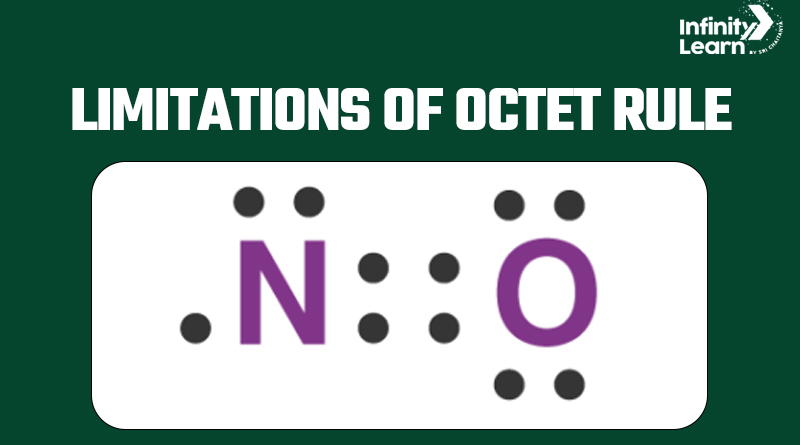Table of Contents
In 1916, Kössel and Lewis proposed a significant idea about how atoms join together in chemicals, called the electronic theory of chemical bonding. They explained that atoms can stick together in two ways: by giving away or taking in valence electrons, or by sharing valence electrons, so they all have eight in their outer shells. This idea is called the Octet rule

Significance of the Octet Rule
The Octet rule, a concept that elucidates chemical bonding in various compounds, offers insights into distinct bond types like covalent, ionic, and coordinate bonds. To put it simply, it explains how atoms form connections in molecules.
Limitations Of Octet Rule
The octet rule is a concept in chemistry that helps explain how atoms bond together. It says that atoms can bond by either sharing their outer electrons with other atoms or by giving away or taking in electrons to have eight electrons in their outer shell. This rule is part of a larger idea that says atoms are most stable when their outer shell is full.
However, there are some situations where the octet rule doesn’t work well:
- Incomplete Octet: Some atoms, especially those with fewer than four outer electrons, don’t follow the octet rule. For example, elements like Li, Be, and B may not have eight electrons in their outer shell when they form compounds, like LiCl, BeH2, or BCl3.
- Odd-Electron Molecules: Some molecules have an odd number of electrons, like nitric oxide (NO) and nitrogen dioxide (NO2). In these cases, not all the atoms can satisfy the octet rule.
- Expanded Atom: Elements in the third row of the periodic table and beyond have additional orbitals available for bonding. These elements can have more than eight valence electrons around them. This is called an “expanded octet.” Compounds like PF5, SF6, H2SO4, and certain coordination compounds fall into this category.
So, while the octet rule is a helpful guideline, it doesn’t always apply to every molecule, especially in these specific cases.
Other Drawbacks of the Octet Theory
he Octet Theory, also known as the Octet Rule, is a fundamental concept in chemistry that states that atoms tend to gain, lose, or share electrons to achieve a stable electron configuration with eight electrons in their outermost energy level. While the Octet Theory is useful for understanding chemical bonding in many cases, it has several drawbacks:
- Limited applicability: The Octet Rule works well for elements in the second period (e.g., carbon, nitrogen, oxygen), but it doesn’t explain the behavior of elements beyond the second period, such as phosphorus or sulfur, which can exceed the octet.
- Incomplete representation: Some molecules and ions do not follow the Octet Rule. For example, molecules with an odd number of electrons or species like hypervalent compounds (e.g., SF6) don’t conform to the octet.
- Ionic compounds: The Octet Rule primarily applies to covalent bonding and does not account for the formation of ionic compounds, where atoms gain or lose electrons to achieve a noble gas electron configuration.
- Ambiguity in resonance structures: In some cases, molecules have multiple resonance structures, leading to ambiguity in assigning electron distributions, which the Octet Rule does not address effectively.
- Doesn’t consider electronegativity: The Octet Rule doesn’t account for differences in electronegativity between atoms, which play a crucial role in determining the distribution of electrons in chemical bonds. It doesn’t explain the concept of polar covalent or ionic bonds.
While the Octet Theory serves as a useful guideline for understanding chemical bonding in many situations, it’s important to recognize its limitations and consider more advanced theories, such as molecular orbital theory and valence bond theory, for a deeper understanding of molecular structure and bonding.
FAQs on Limitations of Octet Rule
What are the limitations of the octet rule for hydrogen?
Limitations of the octet rule for hydrogen: Hydrogen can only form 1 bond, not 2 as suggested by the octet rule.
What are the three main exceptions to the octet rule?
Three main exceptions to the octet rule: H, He, and Li often have fewer than 8 electrons in their valence shells.
What are the limitations of incomplete octet rule?
Limitations of incomplete octet rule: It doesn't apply to elements beyond the second period, and it may lead to unstable compounds.
What is the octet rule and its limitations and significance?
Octet rule and its significance: It guides chemical bonding but has exceptions due to variations in electron distribution.
What are the exceptions of octet rule Class 11?
Exceptions to octet rule in Class 11: Common examples include H2O, NO2, and SO3.
Which four elements do not follow the octet rule?
Four elements not following the octet rule: Hydrogen, helium, lithium, and beryllium.
Which molecule does not obey octet rule?
Molecule not obeying octet rule: Boron trifluoride (BF3) doesn't achieve an octet due to its electron deficiency.
Why does BF3 violate the octet rule?
Why BF3 violates the octet rule: BF3 lacks sufficient valence electrons to complete an octet for boron, resulting in an electron-deficient structure.







